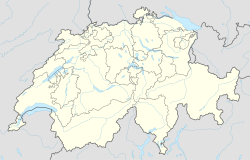Top Qs
Timeline
Chat
Perspective
St. Pierre Cathedral
Church in Geneva, Switzerland From Wikipedia, the free encyclopedia
Remove ads
Saint Pierre Cathedral is a historic church in Geneva, Switzerland. It was originally a Roman Catholic cathedral but became a Calvinist Church in 1535. It is known as the adopted home church of John Calvin, one of the leaders of the Protestant Reformation. Inside the church is a wooden chair used by Calvin.
This article needs additional citations for verification. (June 2020) |

Remove ads
History
Summarize
Perspective
Below the cathedral is an accessible archaeological site that includes a 1st-century BC tomb of an ancient Allobrogian chieftain.[1] An oppidum erected on the hill of Saint-Pierre allowed them to control the inland navigation on the Rhône.[2] In the 4th century AD, Geneva became the seat of a bishopric. The first Christian edifice was built on the hill (between 350 and 375), on the ruins of the Roman sanctuary. This “northern cathedral” and a first baptistry were soon complemented by a southern cathedral, a second baptistry and an atrium.
After a fire struck the north cathedral in the year 500, King Sigismund of Burgundy rebuilt it and asked Pope Symmachus to bring him the relics of St Peter. The present building was begun under Arducius de Faucigny, the prince-bishop of the Diocese of Geneva, around 1160,[3] in Gothic style. The interior of the cathedral is lined with fourth-century mosaics. The German painter Konrad Witz painted an altarpiece, the so-called St. Peter Altarpiece, for the cathedral in 1444, now in the Musée d'Art et d'Histoire, Geneva, which contains his composition, the Miraculous Draught of Fishes.[citation needed]
At the time of the Reformation, the interior of the large, cruciform, late-gothic church was stripped of its rood screen, side chapels, and all decorative works of art, except the stained glass, leaving a vast, plain interior that contrasts sharply with the interior of surviving medieval churches that remain Roman Catholic. A Neo-Classical main façade was added in the 18th century.[3] In the 1890s, Genevans redecorated a large, side chapel adjacent to the cathedral's main doors in a polychrome, Gothic Revival style.
Theodore Beza, French Calvinist Protestant theologian, reformer and scholar, and successor to John Calvin, was buried at St. Pierre in 1605.
Remove ads
Present day
Currently, every summer a German Protestant minister is present, making it possible to hold bilingual services and meetings of both German and French Protestant worshippers. [citation needed]
On Whit Saturday, 30 May 2020, after nearly 485 years[4] a Catholic Mass was to be celebrated in the cathedral as a symbol of ecumenical hospitality.[5] Because of COVID-19, the Catholic Mass was postponed and was celebrated on Saturday, 5 March 2022.
On certain nights of the full moon, the cathedral sponsors "The Nocturnes de St-Pierre", an opportunity to access the towers for a panoramic view of the surrounding countryside by moonlight.[6]
Remove ads
Bells
Gallery
- Spire of St. Pierre Cathedral
- Front entrance of the Cathedral at night
- John Calvin's chair
- Jet d'Eau from the north tower of the Cathedral
- Ceiling of the Maccabees Chapel
- Chapelle of St. Pierre Cathedral
See also
References
Further reading
External links
Wikiwand - on
Seamless Wikipedia browsing. On steroids.
Remove ads








